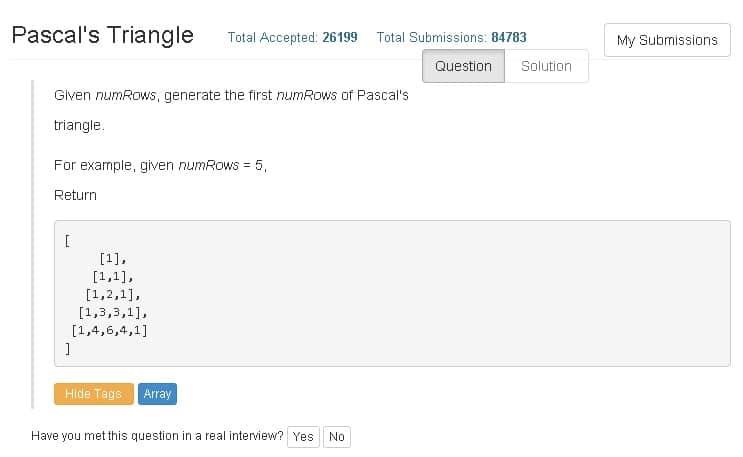The puzzle is to generate the first few numRows rows of Pascal’s Triangle.
Do you need to keep each row in separate variables (row vector)? Apparently no. The trick here is to have a row vector that represents the last row (n) and base on that construct a new row (n + 1). After each iteration, the row vector is pushed back to the result vector. Of course, for each new row, we increase the size of the vector by one element (number 1 is pushed to the right).
1 2 3 4 5 6 7 8 9 10 11 12 13 14 15 16 17 18 19 20 | class Solution { public: vector<vector<int> > generate(int numRows) { vector<vector<int> > r; if (numRows <= 0) { return r; } vector<int> cur; cur.push_back(1); r.push_back(cur); for (int i = 0; i < numRows - 1; i ++) { for (int j = cur.size() - 1; j > 0; j --) { cur[j] += cur[j - 1]; } cur.push_back(1); // right-most 1 r.push_back(cur); } return r; } }; |
class Solution {
public:
vector<vector<int> > generate(int numRows) {
vector<vector<int> > r;
if (numRows <= 0) {
return r;
}
vector<int> cur;
cur.push_back(1);
r.push_back(cur);
for (int i = 0; i < numRows - 1; i ++) {
for (int j = cur.size() - 1; j > 0; j --) {
cur[j] += cur[j - 1];
}
cur.push_back(1); // right-most 1
r.push_back(cur);
}
return r;
}
};Example: 1 – 3 – 3 – 1 ==> 1 – (1+3) – (3+3) – (3+1) and we add 1 to the right at the end of each iteration.
To return the N-th row, we can use a simplified solution: Compute the Nth Row of a Pascal’s Triangle using Dynamic Programming Algorithm
Pascal Triangle Implementations:
- Teaching Kids Programming – Pascal Triangle Algorithms and Applications
- Coding Exercise – Pascal Triangle II – C++ and Python Solution
- How to Print Pascal Triangle in C++ (with Source Code)
- Compute the Nth Row of a Pascal’s Triangle using Dynamic Programming Algorithm
- GoLang: Generate a Pascal Triangle
–EOF (The Ultimate Computing & Technology Blog) —
Last Post: Introduction to programming - C Exercise - Circuit
Next Post: Code Snippet Auto Complete on Switch Statement using enum in Visual Studio
